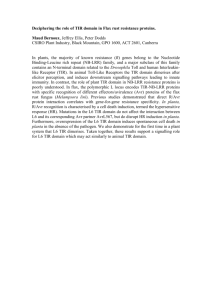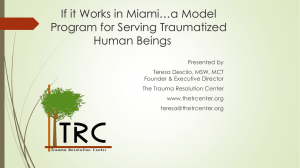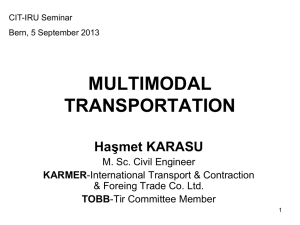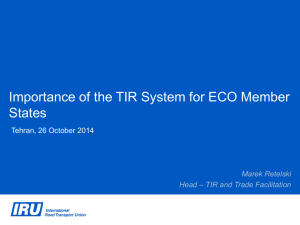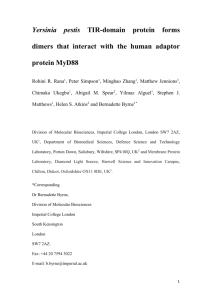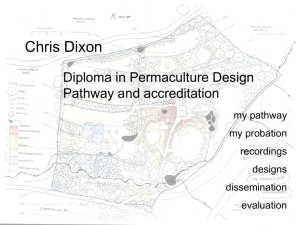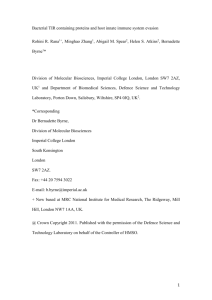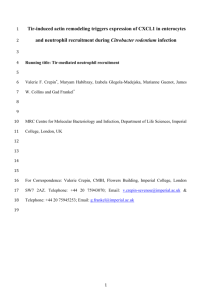TIR in Trade Facilitation for the Region
advertisement
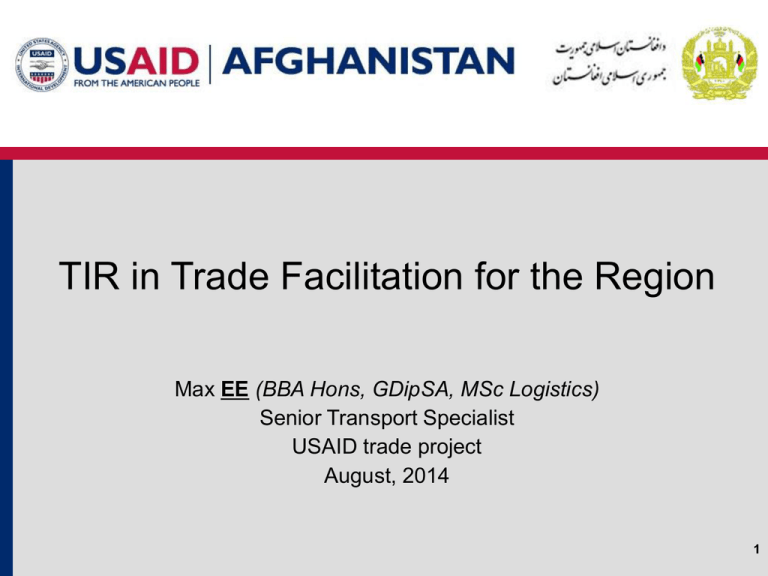
TIR in Trade Facilitation for the Region Max EE (BBA Hons, GDipSA, MSc Logistics) Senior Transport Specialist USAID trade project August, 2014 1 Personal Profile Max Ee Singapore • Senior Transport Specialist, USAID trade project • Ten years of working and operational experience in the private sector, working in third-party logistics (3PL) • Ten years of consulting experience for public and private sectors. • Started work for Asian Development Bank since 2005. • Worked in Afghanistan, Kazakhstan, Kyrgyz Republic, Mongolia, Pakistan, PRC (Xinjiang), Uzbekistan. • Focused on transport and trade facilitation project • Course Convener in Singapore Logistics Association, Director for ASEAN-China Chamber of Commerce 2 Agenda 1 Regional Transit Corridors 2 Regional Trade Flows 3 TIR in Connecting Central and South Asia 4 Road-Map for Implementation 3 Regional Transit Corridors 4 Transit Routes in Afghanistan Uzbekistan-Afghanistan-Pakistan (845 km) Ayratan-Hairatan-Mazari SharifPol e homri-Kabul-JalalabadTorkham-Peshawar Tajikistan-Afghanistan-Pakistan (740 km) Nizhni Panj-Shirkhan Bandar-KundozPol e homri-Kabul-JalalabadTorkham-Peshawar 5 Transit Routes in Pakistan India-Pakistan-Afghanistan (AH-1, 520 km) Wagah-Lahore-PeshawarTorkham Pakistan-Afghanistan (AH-7 1 857 km) Karachi-Khuzdar-QuettaChaman-Spin Buldak Pakistan-Afghanistan-Central Asia (AH-2 and AH-14 1,431 km) Karachi-Sukkur-DI KhanPeshawar-Torkham 6 Transit Corridors with Heavy 5 Traffic CAREC Corridor Shirkhan Bandar – Torkham Urumqi – Dushanbe Hairatan – Torkham Trade Flows Industrial Materials Cotton Machineries Scrap Iron Fruits Cement 7 Pakistan’s Potential in the Region Central Asia Land-locked region Energy-Rich Complicated Border Crossing Middle East Energy-Surplus Region Capital Surplus U.A.E. just acceded to TIR East Asia Economically Vibrant Huge Demand for Energy and Resources Large Demographics South Asia Favourable Demogrpahics Access to seaports 8 Connecting Central and South Asia : Global View 9 Connecting Central and South Asia : Key Questions 1. Central Asian Countries are land-locked and do not access to seaports. 2. Why is Central Asia not using South Asia to access seaports? 3. What Pakistan need to provide, invest and improve to attract more transit trade? 10 Connecting Central and South Asia : TIR’s Role 1. This transit corridor is the shortest path for Central Asia to access seaports. 2. Only land transport is feasible for this route. 3. Rail transport in Pakistan serves mainly passengers. Commercial and noncommercial cargoes move by roads. 4. Using trucks, TIR can facilitate a more efficient and faster way of moving goods in either direction. 11 Annual TIR Carnets in Use (Central Asia) Countries Iran Kazakhstan Kyrgyz Republic Tajikistan Turkmenistan Uzbekistan 2008 48,000 32,150 17,060 400 1,000 5,000 2009 58,000 31,000 15,050 900 2,000 6,500 2010 54,000 30,050 14,050 700 3,200 9,000 2011 78,000 24,500 20,700 1,500 4,700 14,100 2012 85,000 19,000 17,100 2,950 6,000 17,500 2013 105,000 25,000 22,200 3,500 7,500 7,500 Source : IRU Observations In most countries, the use of TIR is increasing rapidly, shown by the increased number of TIR Carnets in use. This is especially so for Afghanistan’s neighbours such as Iran, Tajikistan and Turkmenistan. The successful re-activation of TIR in Afghanistan and Pakistan as a Contracting Party will create a new TIR Corridor linking Central and South Asia. 12 Challenges of TIR Re-Activation in Afghansitan Association Very limited number of TIR Carnet Holder(s) Only three banks offer cargo insurance Not ATI Companies Need financing to invest in new secure trucks Weak route planning for international shipments Unfamiliar with costing for international shipments Rudimentary understanding of TIR Implementation Challenges Banks Visa Restrictions Officers at border unsure about the documentation Customs Not conversant with English, French, Russian Risk of abandoning cargoes in foreign countries Poor knowledge of geography, border crossing and routes Drivers Factors highlight in blue and italic can be partially or fully addressed through capacity building 13 Implementation Action 1 : International Agreements Year of Accession to CMR and TIR Countries Azerbaijan Kazakhstan Kyrgyz Republic Tajikistan Turkmenistan Uzbekistan CMR 2006 1995 1998 2002 1996 1995 TIR 1996 1996 1998 2002 1996 1995 Source : United Nations Economic Commission for Europe (UNECE) (www.unece.org/trans/conventn/agreem_cp.html) Note that many Central Asian countries acceded to both CMR and TIR in the same year. There is a good reason for this. Both Conventions are complementary. CMR is the Convention for the Contract of International Carriage of Goods by Road. It deals with the various legal issues in road transport. What is especially lacking in Afghanistan is the absence on the carrier liability issues. If goods are lost or damaged in transit, the carrier has no insurance coverage and the consignee or consignor have little recourse. Accession to the CMR Convention is useful for Afghan transport operators in international transit. 14 Implementation Action 2 : National Legislation • Revision to the Transport Laws Mandatory for international transport operators to have TIR Compliant trucks • Revision to the Customs Code Recognize mutual customs control • Third-Party Carrier Liability Develop and incentivise the underwriting of carrier liability insurance • Green Lanes for TIR Permit faster movement of trucks 15 Implementation Action 3 : Trucks Specifications 16 Implementation Action 4 : Capacity Building TIR User Guide Train the Trainers Framework Overview Secure Vehicle and Container International Guarantee Chain Mutual Acceptance of Customs Controls Administrative Structure TIR Carnet Controlled Access SafeTIR Sheeted Vehicles and Trailers Contractual Mechanisms in TIR System TIR Transport The TIR Carnet Using the TIR Carnet (Association) Admission to the TIR System SafeTIR and CUTE-WISE Siders Dealing with Claims Customs Procedures Using the TIR Carnet (Holder) Using the TIR Carnet (Customs) General Admin Procedures for Holders Anti-Fraud Actions (Association) Termination and Discharge of TIR Operation Using the Certified Report Form Opening a TIR Carnet Suspension and Exclusion Anti-Fraud Measures (Holder) Dealing with Problems EnRoute Returning a TIR Carnet Containers, Tankers and Small Vehicles Approval Certificate and TIR Plate Anti-Fraud Measures (Customs) 17 Implementation Action 5 : Optimize the Admission Process http://www.acci.org.af/services/tir.html 18 Contacts Thank You! Contact : +93 7958 44845 (Afghanistan) Email: max.ee@scmigroup.com Skype : maxkkee Max Ee 19
